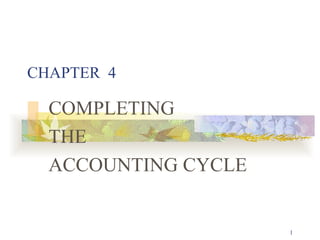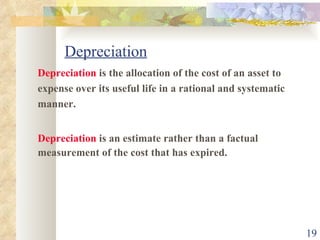Topic 4
- 1. CHAPTER 4 COMPLETING THE ACCOUNTING CYCLE
- 2. 1.Explain how the matching concept relates to the adjusting process 2.Describe the nature of adjusting process 3.Explain how to journalize the adjusting entries 4.Explain how to post the adjusting entries to the ledger 5.Explain how to match the accounts affected by the adjustment with the unadjusted trial balance 6.Explain how to prepare the adjusted trial balance 7.Describe the nature of closing entries 8.Explain how to journalize the closing entries 9.Explain how to post the closing entries to the ledger Topic objectives
- 3. 10.Explain how to prepare post-closing trial balance 11.Explain how to calculate the revenues and expenses to prepare the Income statement 12.Explain how to calculate beginning capital, additional investment, net income (or net loss) and drawing to determine ending capital to prepare the Statement of owner’s equity 13.Explain how to calculate total assets, liabilities, owner’s capital and drawing to prepare the Balance sheet Topic objectives (cont’d)
- 4. OUTLINE Adjusting Entries Preparing the Adjusted Trial Balance Closing Entries Preparing the Financial Statements Income Statement Statement of Owner’s Equity Balance Sheet
- 5. The Accounting Cycle Source Documents Journal Ledger Trial Balance Adjustments Adjusted Trial Balance Financial Statements Closing Entries
- 6. Fiscal year Vs Calendar year Fiscal year Calendar year 1 st day of a month and ends twelve months later on the last day of a month. 1 st January to 31 st December
- 7. Accrual Vs Cash-basis accounting Accrual Cash-basis revenue is recorded when cash is received, and expenses are recorded when cash is paid. revenue and expenses are recognized at the time they take place, and not at the time they are actually paid.
- 8. Recognition of Revenue & Expenses REVENUE RECOGNITION PRINCIPLE THE MATCHING PRINCIPLE revenue be recognized in the accounting period in which it is earned. efforts (expenses) be matched with accomplishments (revenues).
- 9. The Need for Adjusting Entries 1 Revenues to be recorded in the period in which they are earned , and for...... 2 Expenses to be recognized in the period in which they are incurred .
- 10. The Basics of Adjusting Entries Prepayments Prepaid Expenses Expenses paid in cash and recorded as assets before they are used or consumed Unearned Revenues Cash received and recorded as liabilities before revenue is earned
- 11. The Basics of Adjusting Entries Accruals Accrued Revenues Revenues earned but not yet received in cash or recorded Accrued Expenses Expenses incurred but not yet paid in cash or recorded
- 12. Prepaid Expenses Prior to adjustment, assets are overstated and expenses are understated . The adjusting entry results in a debit to an expense account and a credit to an asset account.
- 13. Prepaid Expenses Asset Expense Unadjusted balance Credit Adjustment Debit Adjustment
- 14. Prepaid Expenses Supplies Insurance Depreciation Examples
- 15. Supplies An inventory count reveals that RM1,000 of RM2,500 of supplies are still on hand. Adjustment: Dr. Supplies Expense 1,500 Cr. Office Supplies 1,500 Dr. Office Supplies 2,500 Cr. Cash 2,500 Entries before adjustment: Adjusting entries:
- 16. Supplies Office Supplies Supplies Expense Cash 2,500 Supp. Exp 1,500 Off. Supp. 1,500
- 17. Insurance Insurance premium paid for one year amounting to RM1,200; Expires every month RM100. Adjustment: Dr. Insurance Expense 100 Cr. Prepaid Insurance 100 Entries before adjustment: Adjusting entries: Dr. Prepaid Insurance 1,200 Cr. Cash 1,200
- 18. Insurance Prepaid Insurance Insurance Expense Cash 1,200 Ins. Exp 100 Pre. Insurance 100
- 19. Depreciation Depreciation is the allocation of the cost of an asset to expense over its useful life in a rational and systematic manner. Depreciation is an estimate rather than a factual measurement of the cost that has expired.
- 20. Depreciation In recording depreciation, Depreciation Expense is debited and a contra asset account, Accumulated Depreciation , is credited The difference between the cost of any depreciable asset and its related accumulated depreciation is referred to as the book value of the asset.
- 21. Depreciation Depreciation Methods Straight Line Method Reducing Balance Method
- 22. Depreciation Straight-line depreciation allocates equal amount of an assets net cost to depreciation during the estimated useful life. Eg: Equipment costing RM26,000, estimated to have a useful life of 4 years and expected to be sold for RM8,000 at the end of the 4 th year. Formula: Cost - Scrap Value Estimated useful life
- 23. Depreciation Calculation: RM26,000 - RM8,000 4 years = RM4,500 per year Adjusting entries: Dr. Depreciation Expense 4,500 Cr. Accumulated Depn. 4,500
- 24. Depreciation Depreciation Expense Accumulated Depn. Off. Eqpt. 4,500 Depn. Exp. 4,500
- 25. Depreciation Reducing Balance depreciation : Eg: Equipment costing RM35,000, accumulated depreciation RM5,250. The depreciation rate is 15% on book value. Formula: Net Book Value x Depreciation rate (Cost - Accumulated Depn) x Depreciation rate
- 26. Depreciation Calculation: (RM35,000 - RM5,250) x 15% = RM4,463 per year Adjusting entries: Dr. Depreciation Expense 4,463 Cr. Accumulated Depn. 4,463
- 27. Unearned Revenues Prior to adjustment, liabilities are overstated and revenues are understated . The adjusting entry results in a debit to a liability account and a credit to a revenue account. Examples of unearned revenues include rent, magazine subscriptions, and customer deposits for future services.
- 28. Unearned Revenues Liability Revenue Unadjusted balance Credit Adjustment Debit Adjustment
- 29. Unearned Revenues RM2,000 subscription fees has been earned, out of RM5,000 unearned subscription fees that has been received last month. Adjustment: Dr. Unearned Subscription Fees 2,000 Cr. Subscription Fees 2,000 Dr. Cash 5,000 Cr. Unearned Subscription Fees 5,000 Entries before adjustment: Adjusting entries:
- 30. Unearned Revenues Unearned Subscription Fees Suscription Fees Subscription Fees 2,000 Balance 5,000 Unearned Subscription Fees 2,000
- 31. Accrued Revenues Prior to adjustment, assets and revenues are understated. Accrued revenues may accumulate with the passing of time or through services performed but not billed or collected. The adjusting entry requires a debit to an asset account and a credit to a revenue account.
- 32. Accrued Revenues Asset Revenue Debit Adjustment Credit Adjustment
- 33. Accrued Revenues The company has completely performed the audit service but has not bill the customer yet, RM7,000. Adjustment: Dr. Account Receivable 7,000 Cr. Audit Fees 7,000 Adjusting entries:
- 34. Accrued Revenues Account Receivable 7,000 Audit Fees Audit Fees 7,000 Account Receivable
- 35. Accrued Expenses Prior to adjustment, liabilities and expenses are understated. The adjusting entry results in a debit to an expense account and a credit to a liability account.
- 36. Accrued Expenses Expense Liability Debit Adjustment Credit Adjustment
- 37. Accrued Expenses Salaries accrued at the end of the month RM4,000. Adjustment: Dr. Salary Expense 4,000 Cr. Salary Payable 4,000 Adjusting entries:
- 38. Accrued Expenses Salary Exp. 4,000 Audit Fees Salary Payable 4,000 Salary Expense
- 39. Summary of Adjusting Entries Types of Accounts Before AdjustingEntries Adjustments Adjustments Prepaid Expenses Assets overstated Expenses understated Dr. Expense Cr. Asset Unearned Revenues Liabilities overstated Revenues understated Dr. Liability Cr. Revenue Accrued Revenues Dr. Asset Cr. Revenue Dr. Expense Cr. Liability Assets understated Revenues understated Accrued Expenses Liabilities understated Expenses understated
- 40. The adjusted trial balance An Adjusted Trial Balance is prepared after all adjusting entries have been journalized and posted. Its purpose is to prove the equality of the total debit and credit balances in the ledger after all adjustments have been made. Financial statements can be prepared directly from the adjusted trial balance.
- 41. Closing Entries Temporary / Nominal Accounts Permanent / Real Accounts All revenue accounts All expense accounts Owner’s drawings All asset accounts All liability accounts Owner’s capital account C L O S E C N L O O T S E
- 42. Closing Entries Revenues Expenses Income Summary Drawings Owner’s Capital
- 43. Closing Entries Revenues Expenses Dr. Revenue Account Cr. Income Summary Dr. Income Summary Cr. Expense Account
- 44. Closing Entries Drawings Dr. Owner’s Capital Cr. Drawings Account Income Summary Loss Profit Dr. Income Summary Cr. Owner’s Capital Dr. Owner’s Capital Cr. Income Summary
- 45. Preparing the Financial Statements ~ The income statement is prepared from the revenue and expense accounts . ~ The owner’s equity statement is derived from the owner’s capital and drawing accounts and the net income (or net loss ) from the income statement . ~ The balance sheet is then prepared from the asset and liability accounts and the ending owner’s capital balance as reported in the owner’s equity statement .
- 46. Thank You














































